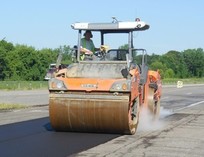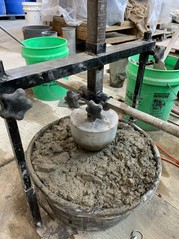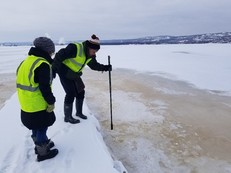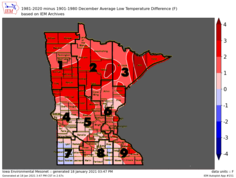|
Transportation Research Update
 Improving Asphalt Performance and Durability With Superpave 5

MATERIALS & CONSTRUCTION - Minnesota’s winter weather is hard on pavement. Rutting and cracking result from cold temperatures, precipitation and freeze-thaw cycles. Engineers address these issues by designing dense and compactable asphalt mixtures that are more durable against the elements. Asphalt densities in the laboratory, however, do not always translate to denser pavements in the field. A new Superpave mix potentially solves this problem.
Building on previous MnDOT efforts, researchers tested a range of asphalt mixes used in road projects to understand the correlations between the properties of the asphalt material and pavement densities in the field. With that knowledge, they modified traditional Superpave mixes to develop an asphalt mixture with the same density both in the lab and as constructed on the roadway. Superpave 5 mixtures can be made with local materials, potentially adding little to no additional expensive binders. By changing the proportions of different aggregate sizes in the asphalt mix, pavements can perform better and last longer. MnDOT will use the new mix in pilot projects across the state to determine if any refinements are necessary before making Superpave 5 standard practice.
|
Fiber-Reinforced Concrete’s Potential as a Performance Engineered Mixture

MATERIALS & CONSTRUCTION - Minnesota pavement must withstand cold temperatures, precipitation and freeze-thaw cycles. Fiber-reinforced concrete (FRC) can be stronger and more durable than plain concrete. Performance engineered mixture (PEM) design for pavements provides for material testing that simulates the actual field conditions of concrete being poured and throughout its service life. The FRC MnDOT uses, however, had not been evaluated with PEM methods.
Researchers tested 57 fiber-containing concrete mixes with specific tests used in PEM design for fresh concrete. Then they investigated the workability of the concrete mixes after vibration; the air content of the wet cement, which indicates resistance to freeze-thaw cycles; and the ability of the mixes to hold their form as they harden. After hardening, the mixes were further tested for strength and durability. Applying the PEM design procedure to FRC, researchers demonstrated the appropriate characteristics for mixes to ensure long-lasting pavements that reduce maintenance costs and improve road quality.
|
Managing Building Assets With Scanning and Reality Modeling

BRIDGES & STRUCTURES - Maintaining, repairing and improving MnDOT’s approximately 900 buildings first requires detailed and extensive site data to be collected. Traditionally, multidisciplinary MnDOT teams travel, often repeatedly, to research or materials facilities, truck stations and other buildings to measure and inspect entire buildings and sites. Scanning and imaging technologies can collect more data more quickly and without normal staff safety concerns. Building on previous research, a recent project showed great potential for improved data-collecting practices.
Using a variety of drones, 360-degree cameras and laser scanners, investigators collected data on seven MnDOT building sites. Post-processing data and applying virtual and mixed reality technologies and tools resulted in 3D models, holographs, floor plans and other products that could save significant resources for the agency. With the ability to collect an estimated 100,000 times the data as could be manually collected, building asset management could be more comprehensive yet efficient and cost-effective. The agency will consider how to integrate these capabilities into building operations.
|
Environmental Evaluations of Potassium Acetate Used as a Road Salt Alternative

ENVIRONMENTAL - Local and MnDOT winter maintenance crews want the safest and most effective ice-fighting products for Minnesota roads in winter. Road salt has been widely used and generally works well to melt ice. However, it is corrosive to metal, accumulates in bodies of water and has substantial environmental impacts. A potential alternative is potassium acetate, which is less corrosive and works at lower temperatures. The environmental impacts of the chemical, however, were less understood.
Two research teams coordinated fieldwork, laboratory analyses and modeling exercises to develop conclusions regarding the environmental consequences of using a potassium acetate product as an alternative deicer and anti-icer. They found that the chemical could be more toxic than anticipated and should be used with caution. Two models that were developed can be used by MnDOT and local agencies going forward to inform when and where to use potassium acetate as a deicer. Standard operating procedures that were developed for water quality sampling will also be helpful to the agencies.
|
Have Minnesota’s Warmer Winters Increased the Number of Freeze-Thaw Cycles?

ENVIRONMENTAL - Minnesota’s winters are among the fastest warming in the U.S. This warming trend is likely increasing the time in which winter temperatures are near freezing, which could increase the number of freeze-thaw events and could have detrimental effects on Minnesota’s pavement systems. When water seeps into pavement and then freezes and thaws, cracks and potholes can occur. The more freeze-thaw cycles there are over a winter season, the more damage to pavement. While MnDOT suspected the warming winters are increasing the number of freeze-thaw events that impact the state’s roads, recent research illustrated this isn’t the case.
A comprehensive analysis of several historical environmental databases, including temperatures and moisture levels in pavement and the subsurface, improved understanding of the state’s changing climate. This allowed researchers to quantify the trends in freeze-thaw cycles in pavement at the MnROAD testing facility. They found that at shallower pavement depths, these cycles are decreasing in early and late winter, and no trend was observed for the remainder of the winter and at deeper layers in the pavement and subsurface. The research team also found, however, that precipitation has increased in early and late winter, which may increase pavement damage. They continue to analyze the relationship between environmental conditions and pavement damage, and will provide MnDOT with practical knowledge and tools to manage sustainable pavement as the climate changes.
|
MnDOT Research in the News
Job Postings
|
|
|
MnDOT invites and encourages participation by all people in their programs, services and activities.
- If you need an ASL, a foreign language interpreter, or documents in an alternative format (such as braille, large print or in a different language) at no cost, please email your request to Janet Miller at ADArequest.dot@state.mn.us or call 651-366-4720. Relay service: 711.
- If you need any another reasonable accommodation to participate (such as seating modification or auxiliary aids), please email your request to Accessibility.DOT@state.mn.us or call 1-833-400-8432. Relay service: 711.
|
|
|
|
|